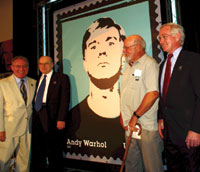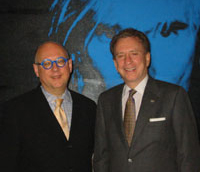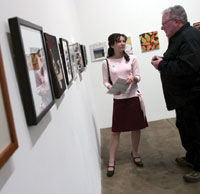
The Warhol’s preview
party for its 2000 exhibition Possession Obsession
pushed some envelopes and was
ranked by many as one of the year’s best events.
Photo courtesy of the Pittsburgh Tribune-Review
By Lynne Margolis
Andy Warhol left
Pittsburgh as soon as he graduated from college and
never looked back. So when word spread
about the city’s campaign to bring him home—so
to speak—via a new museum, it was natural for
cynics and skeptics to ask, “What for?” It
was a legitimate question. And so was the answer. “Why
not?”
Why shouldn’t Pittsburgh try to identify
itself with one of the most important cultural
figures in the 20th century? Why shouldn’t
Pittsburghers get a tourist attraction that
would put the city on the map for reasons other
than steel and sports, and feed its economy
as well? Local leaders would have been crazy
not to grab an opportunity to embrace and celebrate
Warhol’s link to Pittsburgh, and, if
possible, give this conservative town a much-needed
dose of hipness.
Today, The Andy Warhol Museum
has won many converts. Some naysayers changed
their tunes
after friends, relatives, or business associates
pressed them into service as museum tour guides.
Even those who have never roamed among the
museum’s seven concrete-poured stories
seem to appreciate its importance. They actually
brag about it to outsiders when listing what
makes Pittsburgh—to borrow an old marketing
phrase—someplace special. In fact, now
it’s hard to find a high-profile
local resident who has anything negative to
say about the museum. But Chris Potter, managing
editor of the weekly Pittsburgh City Paper,
admits he was one of those early doubters. “I
was writing about art in those days and I tended
to think that Warhol actually was a sort of
pernicious influence on art. An undeniable
influence, but a pernicious one,” he
recalls. “It’s obvious that he
felt he was better off without the city and,
to a large extent, the city returned the sentiment.”
Potter
says he feared the new institution would be
the museum equivalent of Warhol’s
art: an ironic monument to consumerism and
as superficial as the artist himself had sometimes
described his work. Now, Potter says, “I’m
very glad the museum is here. The staff does
a better job of being Warhol than Warhol did.”
Broadening Minds, Attracting Business
Like Potter, Pittsburgh City Councilman Bill
Peduto also has a responsibility to look
at the city’s assets and shortcomings
with a clear eye. As far as he’s concerned,
there’s no question about the museum’s
status as one of the city’s most important
institutions.
“
To me, The Warhol is the equivalent of the
Van Gogh museum in Amsterdam,” he says. “In
the minds of people in the U.S. and throughout
the world, Pittsburgh has become a destination
for art.”
No one has to tell that to Tinsy
Lipchak, director of tourism and cultural heritage
at the Greater
Pittsburgh Convention & Visitors Bureau,
who says visitors leave Pittsburgh with a completely
different attitude than they had when they
arrived. “The Warhol helps change people’s
perceptions of Pittsburgh as a dirty, smoky
city,” she says. “It tells people
that there is a contemporary art scene here.”
Both
Lipchak and Peduto have observed growth in
the number of artists choosing to stay in
Pittsburgh, and they attribute that partly
to the museum’s
presence. Says Peduto: “The Warhol offers
a sense of hope for those young artists who
know there is such a thing as urban chic in
a town like Pittsburgh. It really gives them
a sense of pride and identity like other people
find with the Steelers.”
 |
 |
| Andy Warhol
Foundation President Joel Wachs, John and
Paul Warhola, and Pittsburgh Mayor Tom
Murphy preside over the Andy Warhol commemorative
postage stamp in 2002. |
The Warhol
Director Thomas Sokolowski with U.S. Senator
Arlen Specter at the opening for the recent
exhibition November 22, 1963: Images, Memory,
Myth. Specter spoke at The Warhol about
his experience as a young lawyer on the
Warren Commission. |
 |
 |
| An outdoor
party complete with hotdogs and badminton
kicked off The Summer of Andy, a season-long
celebration of the year of Andy Warhol’s
75th birthday. |
A local
artist discusses her work at the opening
of AMP at The Warhol, a showcase of Pittsburgh
area visual artists presented in collaboration
with the Sprout Fund. |
The Warhol has
also become a hub for Pittsburgh’s
underground art cognoscenti, just as Warhol’s
Factory in New York City provided an outlet
for the avant-garde, untraditional set. “It’s
The Warhol, so it’s cool,” Peduto
says.
Cool quotient is a major concern in a
city desperately trying to attract and retain
a
young professional crowd—an imperative
if it expects to reverse population
losses, maintain its tax base, and lure new,
job-producing businesses.
It certainly has generated
development on Pittsburgh’s
North Shore. As one of the first organizations
to call the Allegheny River section of the
North Shore home, The Warhol is a strong anchor
to developers and is credited with being one
of the pioneers in the rebirth of the entire
area.
Bill Flanagan, chief communications officer
for the Allegheny Conference on Community Development,
says one of the reasons Alcoa built its headquarters
on the North Shore was to be close to The Warhol.
In fact, he and Peduto are both convinced the
city would not have one of its newer jewels—the
Pirates’ PNC Park—if The Warhol
were somewhere else.
Breaking Barriers, Creating Change
Creating opportunities for freedom of expression
is another important aspect of The Warhol’s
mission, and museum Director Thomas Sokolowski
wins unanimous praise for turning that objective
into reality.
One reason Warhol is considered
such a pivotal figure in the art world and
popular culture
in general is because he busted the barriers
between high and low art. And in the process
of questioning established values, he redefined
common notions of what art is all about.
Sokolowski’s
fans say he performs a similar role for Pittsburgh.
Using the mantle of respectability
provided by the museum’s stature as an
art institution, Sokolowski is able to follow
Warhol’s example in searching for the
cutting edge of art and society—and occasionally,
jumping over that edge. Says Potter: “The
tendency in Pittsburgh is, ‘Let’s
put up some art that’s inoffensive that
everybody can feel warm and fuzzy about.’ And
what Tom’s saying is, ‘The only
purpose of art isn’t to feel warm and
fuzzy about it.’”
Potter describes
Sokolowski as something of a gadfly, unafraid
to offer his opinion—an
important role “in a city not used to
having gadflys.” Adds Peduto: “He’s
created a debate not only around art, but also
around cultural and political issues that had
been missing.”
Sokolowski wins kudos
for using an exhibition of Warhol’s electric
chair series as an opportunity to generate
discussion about
controversial death penalty laws. An even more
disturbing exhibition, Without Sanctuary:
Lynching Photography in America, was designed
with the specific intent of providing a deeper
awareness—and
even provoking outrage—in order to stimulate
dialogue and, ideally, greater understanding
of the issue of race relations in this country.
 That
2001 exhibition is regarded as a milestone
in The Warhol’s history, not only for
its bravery in presenting images and raising
issues many museums would not have touched,
but also because it provided a different perspective
of a museum’s function in a community.
To help the public tackle the unsettling emotions
and complex issues triggered by the exhibition,
The Warhol partnered with many groups outside
of the museum. Forums, films, performances,
video diaries, and a daily public dialogue
also helped visitors work through, both alone
and with others, the disturbing feelings caused
by the photographs. That
2001 exhibition is regarded as a milestone
in The Warhol’s history, not only for
its bravery in presenting images and raising
issues many museums would not have touched,
but also because it provided a different perspective
of a museum’s function in a community.
To help the public tackle the unsettling emotions
and complex issues triggered by the exhibition,
The Warhol partnered with many groups outside
of the museum. Forums, films, performances,
video diaries, and a daily public dialogue
also helped visitors work through, both alone
and with others, the disturbing feelings caused
by the photographs.
“People’s thought
processes have to have changed after seeing
that,” says
the Urban League’s Lee Hipps of Without
Sanctuary. Photo:Terry Clark
“
The lynching display did a great deal to give
me a different feeling about the museum,” says
Lee Hipps of the Urban League of Pittsburgh. “Having
seen it gave me a greater appreciation for
what my ancestors had to go through for us
to be where we are today. People’s thought
processes have to have changed after seeing
that, and those sort of things are going to
help us move forward.”
As Flanagan observes, “Isn’t that
the role of a cultural institution—a
good one—to shake things up?”
Back to Contents |